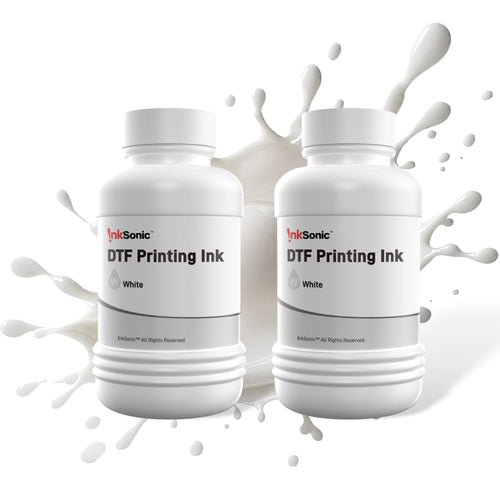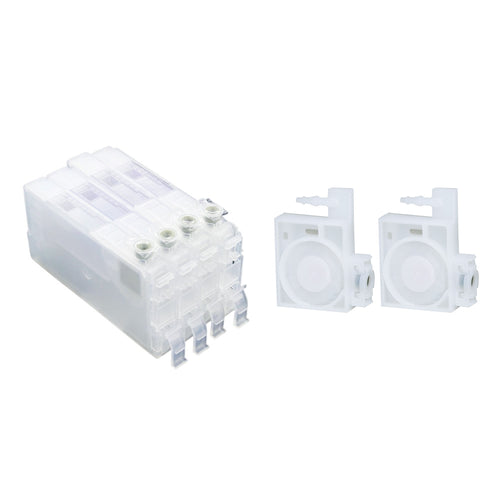Have you ever stopped to think why certain custom prints look breathtakingly gorgeous while others appear scratched or faded? Often times, the answer lies within the ink.
As a creator and small business owner, you really want ink that gives you vibrant colors that pop, can withstand abuse for everyday use, and can stick to just about anything - glass, metal, wood, plastic, curves, and some irregular patterned surfaces. UV DTF inks are uniquely formulated to do just that. UV DTF inks can be cured instantly with UV light, locking in sharp details and colors that stand up to scratching and fading over time.
Let's take a closer look at the unique aspects of UV DTF inks - and why they are the key to eye-popping prints.

What is UV DTF Ink?
UV DTF ink is a water-based ink designed for UV DTF printing (direct-to-film) so that you can transfer to many surfaces. UV DTF ink differs from UV ink used with direct-to-object printing in that UV ink prints directly onto an object and is an oil-based ink. While UV DTF ink is printed on a transfer film with layers -- most often color and varnish -- UV DTF ink is cured immediately (or instantly) using UV light. This unique formulation not only makes it greener and easier to use but also has strong adhesion when applied to the ultimate product. UV DTF ink will be very happy with UV DTF transfer film and will be able to provide great color, designs, and sharpness durability on most surfaces (e.g., glass, metal, ceramic, wood, and even curves, and irregular-shaped surfaces).
Think about what makes UV DTF ink unique: The instant curing of the ink under UV light that locks in the brilliant colors and sharp details also allows for a faster production time to help creators crank out more orders in less time! And because of the inherent nature of UV DTF printing, the benefits don't stop there. Using UV DFT ink, there is no need to pre-coat (even on difficult surfaces like glass, metals, or plastics.) Not only does this save time, and reduce material costs, but it opens the door for small businesses and custom creators to offer high-quality and durable designs on more product options.
With these special advantages, UV DTF inks offer unlimited creative freedom for a wide range of applications. The printed images can be transferred onto glass, metal, wood, plastic, ceramic and leather, making them ideal for a wide range of applications, from decorating high-volume promotional items and industrial products to hobby-level personalization such as personalized mugs, phone cases and gifts. Although the prospects are tantalizing, we cannot forget that print quality will ultimately be directly related to the quality of the ink itself.
The Role of Each Ink Type
Applying low-quality or incompatible ink will lead to expensive and annoying problems like clogged print heads, faded colors, or dull, lifeless prints nobody is going to show off. That's why choosing precise, high-quality UV DTF ink suited for your printer is not a luxury—and it's a printer owner's imperative decision that ensures your prints are always sharp, vibrant, and durable.
- CMYK (Cyan, Magenta, Yellow, Black): These are your starting color inks. They blend to form the whole range of colors you see in your designs—those deep reds and dark blues to light pastels and fine shadowing.
White Ink: It is utilized as a base or background coat, especially when printing dark or transparent colors. Without it, colors can be faded or uneven. The white ink causes your colors to pop out and helps prevent the design from looking faded and hollow.
Gloss/Varnish Ink: This final top coat gives you more than just a shiny finish. It seals in extra scratch protection and prevention against normal wear, and you can get it to look glossy or matte depending on how you set up your print job. It also seals in the ink underneath, so your design is colorful and crisp longer.
All of these inks combined don't just lay down color—create an eye-grabbing professional-grade print that's also long-lasting. Each successive layer of ink plays a role within the process. Collectively, these different inks ensure the resulting transfer is not only sharp and rich in color but will stick to many different surfaces.
What Makes Good UV DTF Ink?
Using poor quality or mismatched ink will result in costly and frustrating issues such as clogged print heads, faded colours, or dull, lifeless prints that no one wants to see. This is why picking accurate, high-quality UV DTF ink designed for your printer is not a luxury—and it’s a printer owner's essential choice that guarantees your prints remain sharp, lively, and long-lasting.
Professional UV DTF printer owners pay special attention to the following factors while sourcing quality ink for their machines:
Performance Metric |
Ideal Quality |
Adhesion |
Strong bonding with A/B film and substrates |
Curing Speed |
Instant with LED UV lamp |
Color Vibrancy |
Bright, full tones without bleeding |
Stability |
Long shelf life and low odor |
Flow Consistency |
Smooth printing, no clogging or sediment |
Investing in the right ink ultimately protects your equipment, saves you time on reprints, and helps your business deliver consistently professional results.
More to Know About UV DTF Ink
While UV DTF printing is known for its ability to decorate complex shapes and various substrates, it is really the UV DTF ink itself that makes this possible. The UV cure in real-time allows the ink to retain strong, rich colors and subtle detail on even smooth shaped and rough hard surfaces without pre-coating them! Special water-based ink formula is also employed to reduce odor and environmental issues compared to oil-based inks.
UV DTF high-quality ink also ensures smoother printing, less print head clogging, and more batch-consistent print outcomes. For businesses and artists, this means less downtime, less waste, and prints that don't fade or lose their deep color and definition over time, and that essentially means UV DTF ink is truly the magic behind the great outcome of having UV DTF printing.
Get the best results from UV DTF ink
As with all aspects of the printing industry, your end results are only as good as your starting materials. In the case of UV DTF inks, ink formulation is just part of the big picture.
For the storage of UV DTF ink, best practice is to store it at room temperature (ideally 20°C to 28°C/68°F to 82°F) with relative humidity of 40% to 60% in order to reduce most common issues caused by ink storage such as clogged nozzles, color variations, or adhesion.
Ensuring that the bottle(s) are sealed tightly takes care of the problem of exposing UV DTF ink to air and potential contaminants which could affect print quality. It is also a good recommended practice to use unopened UV DTF ink within about three months, and opened ink within sixty days, whenever possible to help achieve the intended consistent ink formula and color. Gently shake the ink bottle(s) from time to time will also help reduce pigment settling, which in turn will also help to ensure a smoother printing process and lower risk of nozzle blockage.
Regular maintenance will keep consistent performance as long as you also responsibly store and handle UV DTF ink. Regular maintenance is also important in prolonging the life of the printer.

InkSonic UV DTF ink has been designed to produce vibrantly colorful and top-notch prints with excellent durability and adhesion on glass, metal, wood, plastic, and many other surfaces. Our ink has been created to be consistent and work in a variety of ways, as it cures instantly when exposed to UV light. The colors are scratch-resistant and will not fade when using these products on a daily basis. InkSonic's high-quality UV DTF ink is a great choice to ensure the professional look and durability of your films while limits the risks of issues such as clogging or uneven prints.
Whether you are printing on-demand for your custom print shop or typically manage smaller-batches, investing in a reliable and fully-tested product from InkSonic will keep your prints looking sharp, your process product for daily use, and most importantly - your customers happy.
FAQ
1. What makes UV DTF ink different from regular UV ink?
UV DTF ink is typically water-based , whereas standard UV ink is oil-based . UV DTF ink is designed to work with transfer films, making it possible to decorate curved and uneven surfaces without pre-coating.
2. What surfaces can images printed with UV DTF ink be transferred to?
Products printed with this technology can be used on hard surfaces like glass or plastic, metal or wooden products as well as leather, ceramic and a host of other materials resulting in diverse uses in goods personalization, hobbies, customized products and industrial applications.
3. How should I store UV DTF ink for best results?
UV DTF ink is best stored in 20-28 degrees celsius,83-68 degrees farenheit 40% to 60% relative humidity settings. to ensure preservation keep bottles sealed for use within 3 months while opened bottles must be used within 60 days.
4. Does the product need to be pre-coated with UV DTF ink?
Advantageous to UV printing, UV DTF does not require pre-coating, making for convenience in avoiding lengthy procedures Cut down decal time.
5. Why is it necessary to continually maintain my printer when using UV DTF ink?
Continuing maintenance can help avoid future problems such as clogging nozzles and color discrepancies, and help ensure prints are always crisp, colorful, and that longevity is put on your printer.
6. What do I do when I see that color is disproportionate on my prints?
Disproportionate colors can be caused by poor ink mixing or inconsistent curing while printing. To help prevent this issue, check to make sure your ink is mixed very well before using it, and check to see if the UV curing unit is working at the correct intensity and wavelength. It's also helpful to do a calibration test run before larger production runs to help reduce color discrepancies.
7. Why does the print quality seem to go downhill over time?
Ink quality could be contributed to improper storage or extreme exposure to conditions like excessive heat or direct sunlight, the stored ink should be according to the manufacturer's recommendations to help keep performance consistent by storing at room temperature and away from sunlight. It is always helpful to pay attention to the performance of the ink on a periodic basis to check for inconsistencies while printing.
8. Why does the print not adhere well to the substrate?
Poor adhesion can occur if the substrate is not wholly compatible with UV DTF printing, or the curing did not complete properly. To improve results check to make sure your printing media is UV DTF compatible, that you are using high quality UV DTF transfer films, and that the UV curing process is complete and timing is accurate.
9. Are InkSonic UV DTF inks printer compatible?
We designed InkSonic UV DTF inks to be printer compatible with all UV DTF printers with Epson XP600 & DX7 print heads.
10. If I have used water-based UV DTF ink, can I switch to oil-based ink at a later time?
Not recommended. Oil-based UV inks mixed to or switched from water- based UV DTF ink can cause clogging, damage to the print heads and unstable print quality. Your best bet here is to stick with ink type required by the specifications of your printer.


































